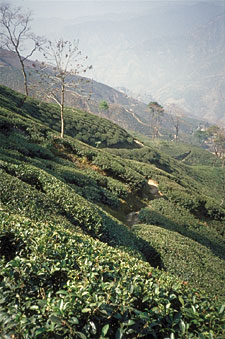Processing
“Tea is a noble tree of the South. It is from one or two feet to several tens of feet high. Near the gorges of the Pa mountains, there is a tea tree that can hardly be hugged by two adult men. Its leaves are harvested after cutting off its branches.”
Master Lu Yu
What we call tea are dried or otherwise processed leaves of Camellia Sinensis. This evergreen shrub or tree comes from what is now the borderland of Burma and China. Botanically, it has two, sometimes three, varieties: Chinese, Assamese and Indonesian. The most widespread Chinese variety is a shrub with smaller dark green leaves, 2 to 3 metres high. Thanks to its height and the quality of tea it gives, it is currently the most common agricultural tea plant. The Assamese type, which comes from the swamp forests of northeast India, has lighter, larger and wider leaves and sometimes it is as high as 20–30 metres. It includes the Indonesian variety, which grows up to 6 meters. Tea plants are often cross-bred and cultivated; there are clones and hybrids, which makes it difficult to clearly define varieties. However, good tea growers know their plantations well and often indicate the origin of their tea plants. However, it has not always been this easy. In an effort to keep their business secrets and the secret of tea for themselves, the Chinese used to misinform and equivocate. It was hard to orient oneself in such a situation. Originally it was mistakenly deemed that there were two tea plants. The Swedish botanist Carl Linné named two different types. Thea bohea, which was supposed to give black tea, and Thea Viridis, on which green tea was supposed to grow. As late as the 19th century it was found that both black and green tea were produced by both the types of the tea plant described by Linné, upon which they were included into a single species. The most common black tea is produced by using the so-called orthodox method from old China. It consists of the following steps: harvesting, withering, oxidation, drying and sorting of finished tea.
Harvesting
It is either manual or mechanised and is often performed several times a year, depending on the weather. The spring flush is usually the most valued, but it is not always the rule. The most delicious aroma and taste are usually given by tiny budding leaves, so-called “pekoe”. They are plucked together with one or more older leaves, thus the denotation P+1 (pekoe+1), P+2, P+3 etc. With older leaves, the quality of tea proportionately decreases.

Withering
Leaves are left to wilt in a dry, airy place for 10 to 16 hours. They lose their fragility and become soft enough to be rolled without being crushed. From the moment a leaf is harvested, chemical reactions take place in it that have a decisive influence on the resulting tea aroma.
Rolling
During this automated process, the cellular structure of the leaf is disturbed and a complex process starts in the juices that are released, which involves many different chemicals and enzymes that enable proper oxidation.
Oxidation
The most important and strictly controlled phase of tea production. It is underway from the harvesting to drying, and partially also during withering and rolling.
The enzymes released from the cells crushed during rolling cause the oxidation of polyphenols.
Drying
The determination of the right moment to stop the oxidation process by drying requires a long experience. The leaves are dried by hot air in belt driers under constant expert supervision. The water content in leaves should be reduced below 3% without burning the leaves, which acquire roasted or caramel flavour. During oxidation and drying, many changes occur that significantly influence tea quality.
Sorting
Dry tea passes through sorting machines where it is sorted by leaf size using vibrating sieves.
Green tea
It is dried as soon as it is harvested. Oxidation does not start at all because the enzymes are destroyed. In China, tea is dried by direct heat in metal cauldrons, woks or hot brick surfaces. In Japan, oxidation is topped by steaming.
Partially oxidised tea
Sometimes it is called semi-oxidized tea, blue-green tea or oolong (from Chinese wu-long, a black dragon – the most famous partially oxidised tea). Tea leaves are only partially damaged, usually shortly fermented and dried – quite fast at relatively high temperatures at first and then slowly at lower temperatures. By combining and repeating these processes, many different flavours and aromas can be achieved. Depending on the degree of oxidation, oolongs can be divided into three groups: fermented above 10, 20 and 40 percent. Over 3,000 kinds of oolongs are known only in China, the country where they come from.